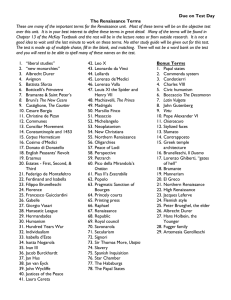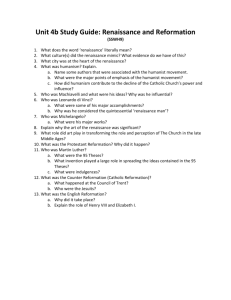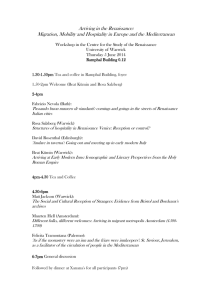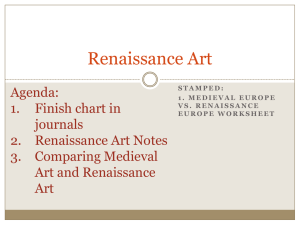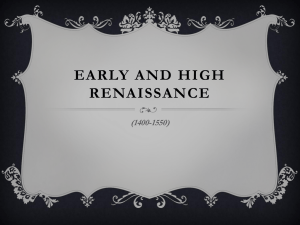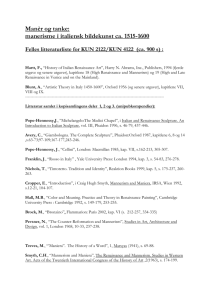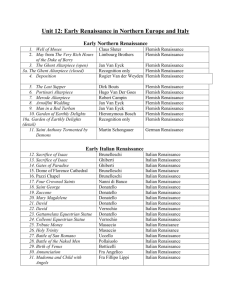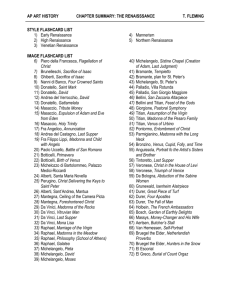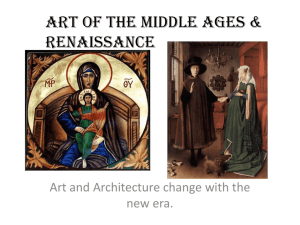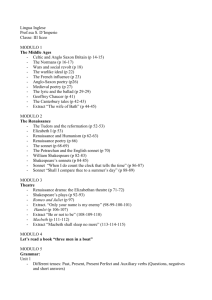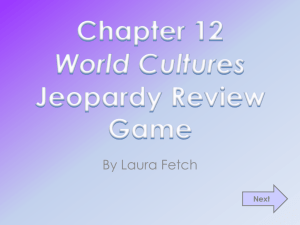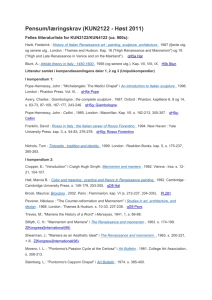HIST 395: Renaissance & Reformation Study Guide for Exam I I
advertisement
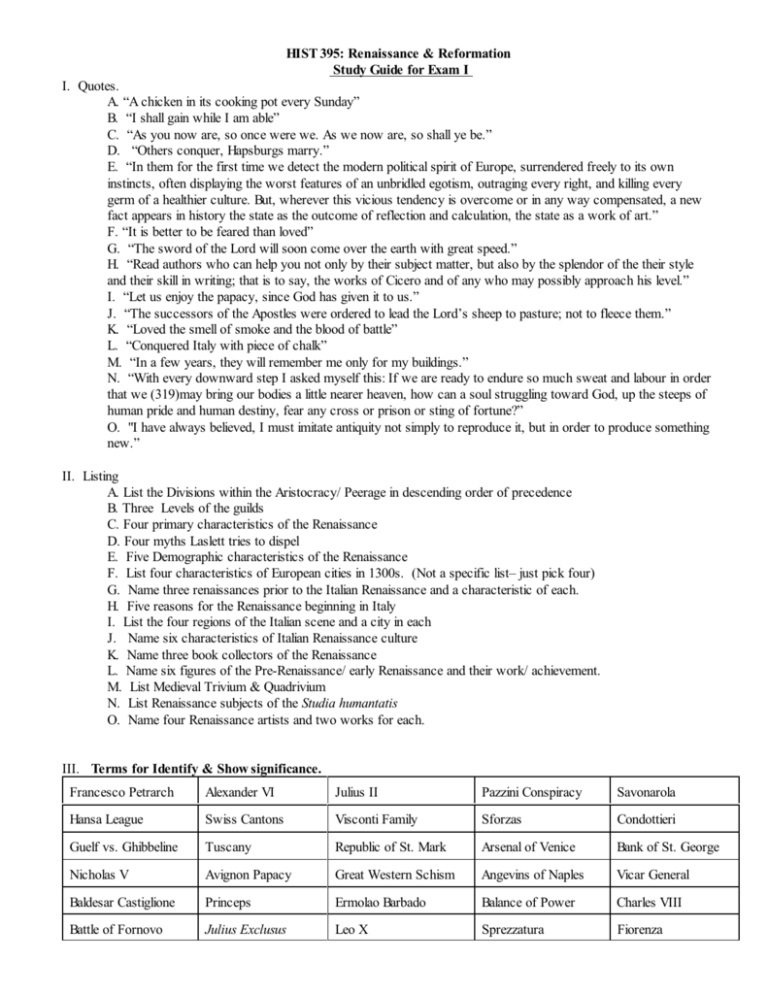
HIST 395: Renaissance & Reformation Study Guide for Exam I I. Quotes. A. “A chicken in its cooking pot every Sunday” B. “I shall gain while I am able” C. “As you now are, so once were we. As we now are, so shall ye be.” D. “Others conquer, Hapsburgs marry.” E. “In them for the first time we detect the modern political spirit of Europe, surrendered freely to its own instincts, often displaying the worst features of an unbridled egotism, outraging every right, and killing every germ of a healthier culture. But, wherever this vicious tendency is overcome or in any way compensated, a new fact appears in history the state as the outcome of reflection and calculation, the state as a work of art.” F. “It is better to be feared than loved” G. “The sword of the Lord will soon come over the earth with great speed.” H. “Read authors who can help you not only by their subject matter, but also by the splendor of the their style and their skill in writing; that is to say, the works of Cicero and of any who may possibly approach his level.” I. “Let us enjoy the papacy, since God has given it to us.” J. “The successors of the Apostles were ordered to lead the Lord’s sheep to pasture; not to fleece them.” K. “Loved the smell of smoke and the blood of battle” L. “Conquered Italy with piece of chalk” M. “In a few years, they will remember me only for my buildings.” N. “With every downward step I asked myself this: If we are ready to endure so much sweat and labour in order that we (319)may bring our bodies a little nearer heaven, how can a soul struggling toward God, up the steeps of human pride and human destiny, fear any cross or prison or sting of fortune?” O. "I have always believed, I must imitate antiquity not simply to reproduce it, but in order to produce something new.” II. Listing A. List the Divisions within the Aristocracy/ Peerage in descending order of precedence B. Three Levels of the guilds C. Four primary characteristics of the Renaissance D. Four myths Laslett tries to dispel E. Five Demographic characteristics of the Renaissance F. List four characteristics of European cities in 1300s. (Not a specific list– just pick four) G. Name three renaissances prior to the Italian Renaissance and a characteristic of each. H. Five reasons for the Renaissance beginning in Italy I. List the four regions of the Italian scene and a city in each J. Name six characteristics of Italian Renaissance culture K. Name three book collectors of the Renaissance L. Name six figures of the Pre-Renaissance/ early Renaissance and their work/ achievement. M. List Medieval Trivium & Quadrivium N. List Renaissance subjects of the Studia humantatis O. Name four Renaissance artists and two works for each. III. Terms for Identify & Show significance. Francesco Petrarch Alexander VI Julius II Pazzini Conspiracy Savonarola Hansa League Swiss Cantons Visconti Family Sforzas Condottieri Guelf vs. Ghibbeline Tuscany Republic of St. Mark Arsenal of Venice Bank of St. George Nicholas V Avignon Papacy Great Western Schism Angevins of Naples Vicar General Baldesar Castiglione Princeps Ermolao Barbado Balance of Power Charles VIII Battle of Fornovo Julius Exclusus Leo X Sprezzatura Fiorenza Peace of Lodi Duke of Urbino Manuscripts collectors Cosimo di Medici Henry VIII Bonfire of the Vanities Wolf of Rimini Pico della Mirandola Lorenzo di Medici Doge of Venice Wat Tyler Rebellion War of the Roses Studia humanitatis Ad fontes William of Ockham Thomas Aquinas Universitas Francesco Guicciardini Lovato dei Lovati Brunetto Latini Albertino Massato Niccolo Machiavelli Fall of Constantinople Italic League Poggio Bracciolini Cesare Borgia Doce Stil Nova Cola di Rienzo Council of Florence Dante Alighieri Civic Humanism Giovanni Boccacio Leonardo Bruni Lorenzo Valla Coluccio Salutati Isabella D’Este Sixtus IV Women humanists Scholasticism scittori Council of Constance Council of Florence IV. Essay Questions 1. Compare and contrast the Italian Renaissance with its predecessors. What made the Italian Renaissance different? Or was it? Discuss the differences. 2. Discuss the situation of Italian politics in the early Renaissance. Consider the characteristics, players, problems and innovations of Italian politics. 3. The other half of the Renaissance is the Reformation. Discuss the characteristics and problems of the Papacy from 1300 -1520. How might this lead to reform? 4. Discuss the progress of the early Renaissance from its first origins to the development of Doce Stil Nova and the subsequent changes in education and thought. Explain the different ideas of the leading figures. 5. Discuss the events and importance of the Pazzi Conspiracy. Explain who the players were and their motives. What does this episode indicate about the nature of Florentine and Italian Renaissance politics? 6. Consider the pros and cons of Medici rule in Florence. What were the arguments for both the Medici and the Florentine Republic? Be sure to come to a conclusion either pro or con. 7. Two of the major powers involved in Italian Politics were the Pope and the HRE. Explain the different factions associated with these two powers, and who supported each side. How did these affect Italian politics? 8. Niccolo Machiavelli’s The Prince discusses the qualities required for a successful ruler. Explain these and how they apply to at least three specific rulers/ people in Renaissance Italian politics. 9. Humanism is uniquely associated with the Italian Renaissance. Discuss the development, definition and importance of humanism within the context of the Renaissance and explore how it developed in the writings of those associated with the Italian Renaissance.
